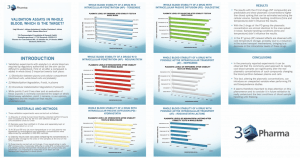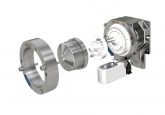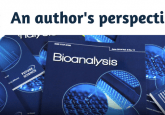9th WRIB LC-MS poster award winner interview

The 9th Workshop on Recent Innovations in Bioanalysis (WRIB) drew close to 600 professionals representing pharmas, biopharmas, biotechs, CROs and multiple regulatory agencies, working on both small and large molecule bioanalysis. This year, Bioanalysis Zone is again proud to support the WRIB Poster Award. Posters were judged by an expert panel at the conference and prizes were awarded for the best poster in the fields of LBAs and LC-MS. Here we present the winning LC-MS poster, along with a short interview with the project leader Luigi Silvestro (3S Pharma).
Click the image below, or click here to view the winning poster: ‘Validation assays in whole blood, which is the target?’
Interview with Luigi Silvestro (3S Pharma)
What is your role at 3S Pharma?
First of all I think it is important to introduce 3S Pharma, otherwise unknown to the majority of people reading this interview. 3S Pharma is a CRO founded in Germany 20 years ago, which has expanded its activity to Eastern-Europe. I am one of the founders of 3S and one of its two managing directors. Besides this, I am also test facility manager for the GLP analytical laboratory and deeply involved in analytical method development. I am a passionate analyst – I consider this work to be very interesting, challenging, with plenty of opportunities for new discoveries, and never boring!
Tell us more about the work behind your winning poster.
Many years ago, at the end of the ‘80s, I was involved in studies addressing the intracellular PK of anticancer drugs as a mechanism of cell resistance. It was during this period that P-glycoproteins were discovered in cells resistant to antracyclines. As a result of this discovery there was a lot of interest in seeing whether other drugs shared similar PK characteristics, as well as into the development of drugs capable of modifying this mechanism of resistance.
Recently, I have been more involved in developing and validating quantitative analytical methods. I often observe unexpected results in experiments that aim to validate whole blood sample stability and define appropriate handling conditions. These findings pushed me to investigate cell partition/penetration passive and/or active in a ’neglected compartment‘ (see Hinderling PH. Red blood cells: a neglected compartment in pharmacokinetics and pharmacodynamics. Pharmacol. Rev. 49(3), 279-295(1997)) represented by circulating blood elements (erythrocytes, leucocytes and platelets). In the last year more systematic experiments have been carried out demonstrating the potential relevance of these mechanisms on plasmatic drug levels in quantitative determinations.
What implications does this work have?
I am clearly tempted to shortcut and simply say ‘we will see’, awaiting more research and further discoveries, but some implications can already be discussed. As a first point it seems clear to me that in the future the distribution between plasma and cellular components shall be much more carefully investigated during method validation; it is indeed important to understand to what extent the plasmatic quantitative determination can be influenced by the primary (at the investigational site) and secondary (in the bio-analytical lab) sample handling procedures.
I fear we will find conflicting situations in which measures (i.e., cold and/or stabilizer) intended to reduce degradation will alter the blood partition between serum/plasma and blood cells, making it very difficult to find the optimal conditions to satisfy stability requirements whilst minimizing changes in partitioning.
In my opinion whole blood PK determinations represent a good way of overcoming the problem, as they have robust methods with optimal stabilizer and avoid all partitioning problems. In the past, when HPLC-UV was the most used analytical technique in PK, whole blood analytical methods were difficult to develop and plasma was considered a better/easier matrix to work with. Nowadays, when LC-MS is the analytical technique, by employing appropriate extraction techniques whole blood analyses are not only feasible but might, in the future, become, the most interesting matrix to work with.
Whole blood presents other interesting features in PK studies too, simplifying sample handling (no need of centrifugation), permitting very fast freezing, virtually avoiding all risk of degradation during the primary sample processing and making all discussion connected to haemolytic samples superfluous.
Furthermore, an appealing aspect is the fact that PK results in whole blood will be easier to compare to the ones obtained by DBS sampling, a rapidly growing method in pharmacology. It is, however, evident that whole blood will not solve all problems and some particular PK studies will still need to be performed in plasma.
A last important point that will influence the development of whole blood methods, as well as deepen the partition problem during method validation, will be the attitude of regulatory authorities on this delicate aspect. It is indeed clear that an acceptance of whole blood determination by regulatory bodies is needed in order to widen the application of this approach. New research data will hopefully help in the acceptance of whole blood PK.
What are you looking forward to working on over the next year?
Work in a CRO is always unpredictable – customer requests strongly influence the activity, and unexpected projects may suddenly alter the planned activities in the coming year. Besides this I am involved in a few challenging projects looking to improve biological sample preparation for LC-MS applications: in this context I am quite interested in an array system for automated solid phase microextraction (SPME) as well as micro-scale extraction methods (i.e. hollow fibres). I am also working on the implementation of ion mobility in combination with LC-MS as a powerful tool to improve analytical selectivity in complex matrices. I hope to have the opportunity to employ HRMS in combination with ion mobility in this area, pushing the analytical specificity further. Along with these innovative ideas, I shall work to continue the research presented in this poster, and publish more on this topic. Depending on the results obtained and the reactions to these results, I shall decide on whether to invest more energy and time to continue in this direction.






